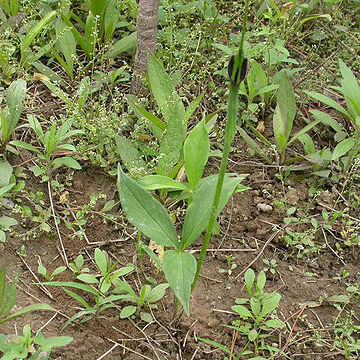Herbs, perennial, seasonally dormant; tuber cormlike, subglobose, or rhizome cylindric; tubercles usually formed around main tuber, on tuber around base area of petioles, or at rhizome ends; bulbils usually at proximal, middle, or distal part of petioles, sometimes on both petiole and base of leaf blade. Leaves 1-5; petiole green, usually unspotted, sometimes spotted; sheath fairly long, very short, or nearly absent; bulbils present or absent; leaf blade simply cordate, ovate, oblong, deeply trifid, or trisect, or pedatisect; leaflets oblong-elliptic to ovate-oblong; primary lateral veins of leaf blade or of each leaflet pinnate, forming a submarginal collective vein, with 1 or 2 distinct marginal veins also present, higher order venation reticulate. Inflorescence solitary, appearing with leaves; peduncle green, shorter or slightly longer than petioles. Spathe persistent, slightly to strongly constricted between tube and blade (except in Pinellia pedatisecta); tube convolute, narrowly ellipsoid to ovate, almost closed within by a transverse septum (except in P. pedatisecta), gaping at base; limb arching, gaping, green to purple, oblong-elliptic, boat-shaped, ca. 2 × or more as long as tube. Spadix much longer than spathe; female zone adnate to spathe, separated from male zone by spathe septum (except in P. pedatisecta) and by short, free, naked part of spadix axis; male zone free, cylindric, short; terminal sterile appendix long exserted from spathe, often sigmoid, narrowly subulate. Flowers unisexual, perigone absent. Male flowers 1-or 2-4-androus; stamens sometimes united congenitally in pairs or groups of 4, short, laterally compressed; anthers sessile, connective slender, thecae ellipsoid, 2-celled, dehiscing by apical slit, rarely each pollen sac opening by a pore. Pollen extruded in amorphous mass, inaperturate, spherical or subspheroidal, small to medium sized, exine spinulose. Female flower (gynoecium, pistil) with ovary ovoid to ovoid-oblong, 1-loculed; ovule 1, orthotropous, funicle very short; placentation basal; stylar region attenuate; stigma small, hemispheric to disciform. Berries green, yellowish green, or whitish, oblong-ovoid. Seeds obnapiform to ellipsoid; testa irregularly verrucose-rugulose or smooth; embryo axile, elongate, or very small and subglobose; endosperm copious. 2n = 26, 28, 52, 54, 72, 78, 104, 115, 116, 128.
More
Spadix adherent to the spathe on one side of the base, bearing pistillate fls on the free side; staminate fls separated from the pistillate by a swollen ring; upper part of the spadix naked; ovary with a single ovule; small stoloniferous herbs, perennial from corms; lvs compound. 7, China and Japan.

